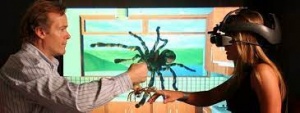Virtual Reality in Psychology and Experiments
Virtual reality (VR) is a term used to describe a 3D, computer generated environment. In this environment, participants can explore areas, create new objects, and manipulate their surroundings. This environment is often viewed through a VR headset that wraps around the participants head and has goggles in which they see the environment through. The Oculus headset, now owned by Meta, is an example of a VR headset. The product was created by Palmer Luckey, and became the company OculusVR in June 2012.[1] Currently, these headsets are used for many activities like video games, listening to music, virtual tours, therapy, and more. Virtual reality is often confused with augmented reality (AR). Augmented reality is a framework based on our world where objects, images, and things are placed. Participants don't always need to wear headsets in AR. An example of an AR mobile app is Pokemon Go. Additionally, mixed reality (MR) is a combination of VR and AR where virtual things are placed in an augmented reality. Mixed reality can make the virtual world indistinguishable from the real world.[2]
Virtual reality can be used for entertainment, communication, learning, therapy, experimentation, and much more. Advancements in VR technology have lead to patients being able to have therapy sessions in any environment without being in real life. This can also be translated to experiments that may be unethical or implausible to run in reality.
Contents
History
The development of VR technology started around the 1950-60's with the Sensorama. This gave users a multi-sensory experience. Throughout the 1960's headsets were created with the advancements of tracking motion and working with computer interfaces. VR was formally conceptualized in 1989, and throughout the 1990's and early 2000's, VR started to be used for psychiatric purposes. Psychiatrists used VR for exposure theory, and studies were conducted to determine if virtual reality exposure therapy (VRE) worked better than traditional therapy. The first study of VRE was focused on the treatment of acrophobia, the extreme fear of heights. [3]
Technology
Field of View and Frame Rate
Most humans can see around a 220 degree radius of surrounding content. VR technology works to emulate this field of view within a virtual world. Currently, most VR headsets only have a 180 degree frame of view. Frame rate refers to how quickly a number of frames appear within a second. The more frames captured, the better the quality of the video (FPS). However, computers can only handle a certain amount of fps, and getting too high of a fps could cause malfunctions. Most television shows and movies are shot at 24-30fps, while video games are usually between 30-60fps. Many video game players opt for higher fps because lower fps on games could lead to choppy game play and a disadvantage against people with higher fps.[4]
Spatial Audio
Position and Tracking
Current Events
Ethical Concerns
Experiments
Psychological Effects
Treatments
VR
Medical Use
References
- ↑ Kumparak, G. (2014, March 26). A brief history of oculus. TechCrunch. Retrieved February 10, 2022, from https://techcrunch.com/2014/03/26/a-brief-history-of-oculus/
- ↑ Corporativa, I. (n.d.). Virtual reality: Another world within sight. Iberdrola. Retrieved January 27, 2022, from https://www.iberdrola.com/innovation/virtual-reality
- ↑ Maples-Keller, J. L., Bunnell, B. E., Kim, S.-J., & Rothbaum, B. O. (2017, May). The use of virtual reality technology in the treatment of anxiety and other psychiatric disorders. Harvard review of psychiatry. Retrieved January 28, 2022, from https://www.ncbi.nlm.nih.gov/pmc/articles/PMC5421394/
- ↑ Whaley, S. (2020, January 31). What is frame rate and why is it important to PC gaming? What is Frame Rate and Why is it Important to PC Gaming? Retrieved February 10, 2022, from https://www.hp.com/us-en/shop/tech-takes/what-is-frame-rate
